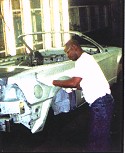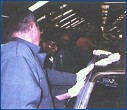 |
|
|
|
The
Classroom and Hands-On Training
|
||
|
|
 |
Metal
Highlighting: By rubbing on the sheet metal surface to be examined, dings or high spots in areas will appear brighter than the surrounding surfaces. Dents or low spots will appear darker than surrounding surface. This is the most widely used technique to distinguish or detect metal defects. |
|||||||||||
| Sight using Light
Reflections: When inspecting the surfaces of sheet metal for defects, the proper procedure is to view the surface light reflected from a given source. By using head, eye, and body movements, the light reflection can be moved along the surface in question. If the surface to be inspected is smooth and free of defects, the movement of the light reflection will be equally smooth. However, if the surface is rough, damaged, or defected the light reflection will break or "dance". The slightest imperfections can be detected using this procedure. |
||||||||||||||
 |
Global Light
Standard: With the introduction of double sided galvanized outer skins (doors, roofs, decks, quarter panels, fenders and hoods) traditional defect detection may require additional hi-lite techniques. As an example, Kansas City Ford Assembly Plant uses a 220 grit E coat type sand screen (on each metal finisher) to hand sand surface to create shine, which aids the operator in visual detection. Again they have created a unique lighting scheme for their metal line that is a combination of yellow, white and obliqueness. This has aided visual detection significantly. Other plants may have body washers or glycerin spray that temporarily adds gloss to the metal. |
|||||||||||||
 |
Touch/feel using
hand movement: Extremely small metal defects are not discovered as accurately by feel as by using light reflection. However, this process can readily reveal warps, buckles, minor dents and dings and is an important skill that metal repair operators must develop. In feeling for defects, the metal finishers hand should be placed flatly on the sheet metal surface. The hand should contact the surface from the palm heel to finger tips with the fingers slightly spread. Defect detection is achieved by drawing the hand backward as the fingers trail the surface. There is little difference in feeling ability in either hand and should be a matter of personal preference. |
|||||||||||||
 |
On Line Repairs: These are repairs that should be completed at the assembly line speed. Small dents or dings, scratches, small metal fatigue splits, solder repair or small gunshot/spot weld gun holes, and necessary trimming of metal parts/flanges. |
|||||||||||||
 |
Off Line Repair: These are repairs that require an extensive amount of time to complete. Large dents or dings as well as large metal fatigue splits, warps/buckles caused by improper part location, and extremely large die marks/pits created during sheet metal formation. |
|||||||||||||
 |
Procedures when
Defects are Identified: Repair the defect or damage. Then mark the defect to be set off and repaired. If possible, identify the source of the defect or damage to defect. Keep the tally sheet for repetition.
|
|||||||||||||
|
[Top] |
||||||||||||||
Best viewed at 800 x 600
Resolution
|